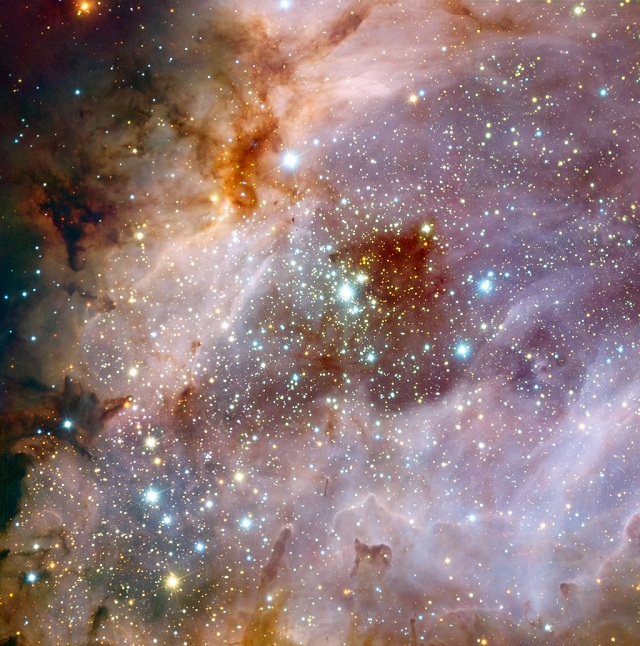By Annelies Rhemrev
October 19, 2012
Messier 17 (the Omega or Swan Nebula), the central part
Image Credit: ESO/R. Chini
For a larger image click here.
Messier 17 (also catalogued NGC 6618, and known as the Omega, Swan, Horseshoe, and Lobster Nebula) is a diffuse emission nebula and H II (star-forming) region, located roughly 5,500 light-years away in the heart of the Milky Way in the constellation of Sagittarius (the Archer). While the bright nebula seems to be roughly 15 light-years across, the total gaseous cloud extends to at least 40 light years.
It is one of the brightest and most massive star-forming regions of our galaxy. The total region of gas, dust and hot young stars has a mass of 30,000 solar masses, while the mass of the bright part of Messier 17 is an estimated 800 solar masses. This image of its central region shows vast clouds of gas and dust illuminated by the intense radiation from young stars.
In the centre of Messier 17 is a cluster of 35 massive young stars whose intense radiation makes the surrounding hydrogen gas glow. However, the actual number of stars in the nebula is much higher -up to 800, plus more than 1000 stars in formation on its outer regions. With an age of just 1 million years it is one of the youngest star clusters known.
To the lower right of the cluster is a huge cloud of molecular gas. At visible wavelengths, dust grains in the cloud obscure our view, but by observing in infrared light, the glow of the hydrogen gas behind the cloud can be seen shining faintly through.
Hidden in this region, which has a dark reddish appearance, the astronomers found the opaque silhouette of a disk of gas and dust. Although it is small in this image, the disc has a diameter of about 20,000 AU, dwarfing our Solar System (1 AU is the distance between the Earth and the Sun). It is thought that this disc is rotating and feeding material onto a central protostar — an early stage in the formation of a new star.
It is a popular target for amateur astronomers, who can obtain good quality images using small telescopes. With a dark observing site and a keen pair of eyes Messier 17 can even be seen with the naked eye.
This composite image is created by using data from ESO’s Very Large Telescope (VLT), at the Paranal Observatory in Chile, made at near-infrared wavelengths with the ISAAC instrument.
Read more on Anne’s Astronomy News



